
Heidelberg
Situated about 75 km south-east of Johannesburg. One of the older towns of the Transvaal with beautiful Victorian architecture and a rich history. GPS coordinates: 26.4992°S 28.3564° Elevation: 1546m
I am here talking about the Heidelberg in Gauteng, not the one far away down there in the Cape and definitely not about the German Heidelberg after which this town has actually been named.
History in general
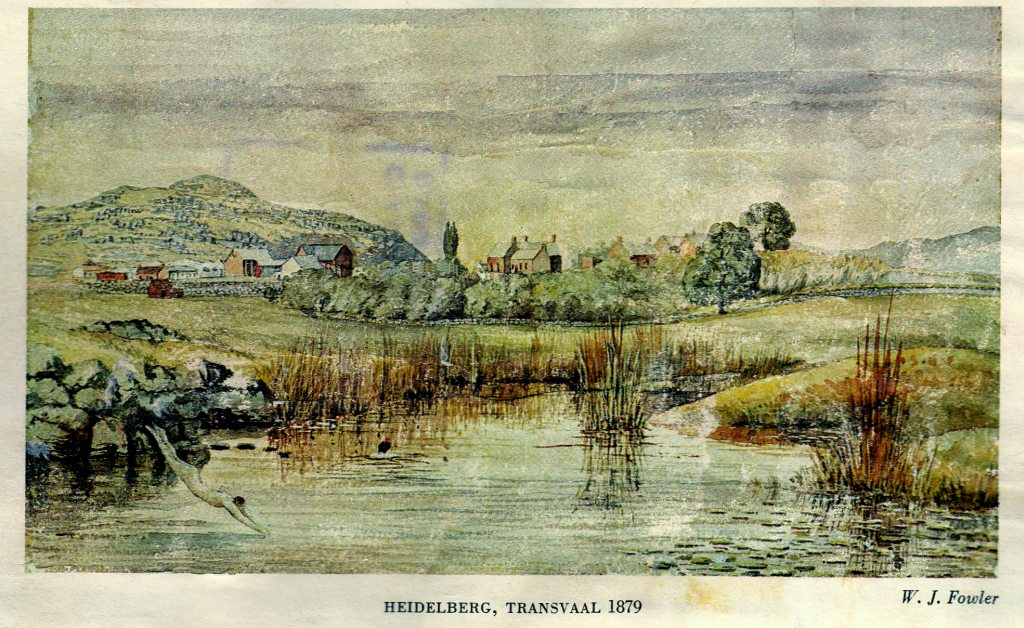 A start was made in 1860 by Heinrich Ueckermann, who had established a trading store on the farm Langlaagte. It was at his initative that the town was laid out and proclaimed in 1866.
A start was made in 1860 by Heinrich Ueckermann, who had established a trading store on the farm Langlaagte. It was at his initative that the town was laid out and proclaimed in 1866.
And history could begin, one of the early travellers writing about the place was EF Sandeman 'Looking down on the village from a mile or two away, it has all the appearance of a pretty, old fashioned German hamlet, but a closer inspection showed it to be a decidedly dirty and unpicturesque little place.' He came through Heidelburg (his spelling) back in 1877 and was not very impressed with the place. I am sure things have improved since then.
For a while it was the seat of government of the Zuid Afrikaanse Repuplik in 1880/81. Heidelberg was selected because it had no British troops stationed there, thus the republic could be re-proclaimed without interference from the military. On the 16 December 1880 (Dingaans Day) the flag was officially hoisted at the town.
It became a municipality in 1903.
Heinrich Ueckermann

 The town basically started with Heinrich Ueckermann, he set up the first trading store in what now is the town. The picture shows the oldest house in town, it was the farmhouse of the farm Langlaagte on which the town has been laid out.
The town basically started with Heinrich Ueckermann, he set up the first trading store in what now is the town. The picture shows the oldest house in town, it was the farmhouse of the farm Langlaagte on which the town has been laid out.
He originated from Germany and named the place after Heidelberg in Germany, that is where he studied. The sources don't reveal what he studied. He arrived in South Africa in `1849, disembarking in Durban. He set up business in Pietermaritzburg and two years later got married to Elizabeth Mary Mason. She bore him 14 children.
After the birth of their first son they trekked extensively by ox-wagon into the interior, as far as the Southpanberge, it was on the trek that their first daughter was born 1856 (a personal note: it is always an amazement to me how tough people were in those days that they could trek for month on end and have babies at the same time). On an other trek he got to the farm Langlaagte and decided that this is a good place to establish a trading store and that way came to an end of their wanderings.
From the farmers Strydom and Venter he purchased a piece of land to set up a trading store. This piece of land still exists as stand no.92 on the corner of Ueckerman- and Kerk street. The picture on the left shows the trading store in the early days.
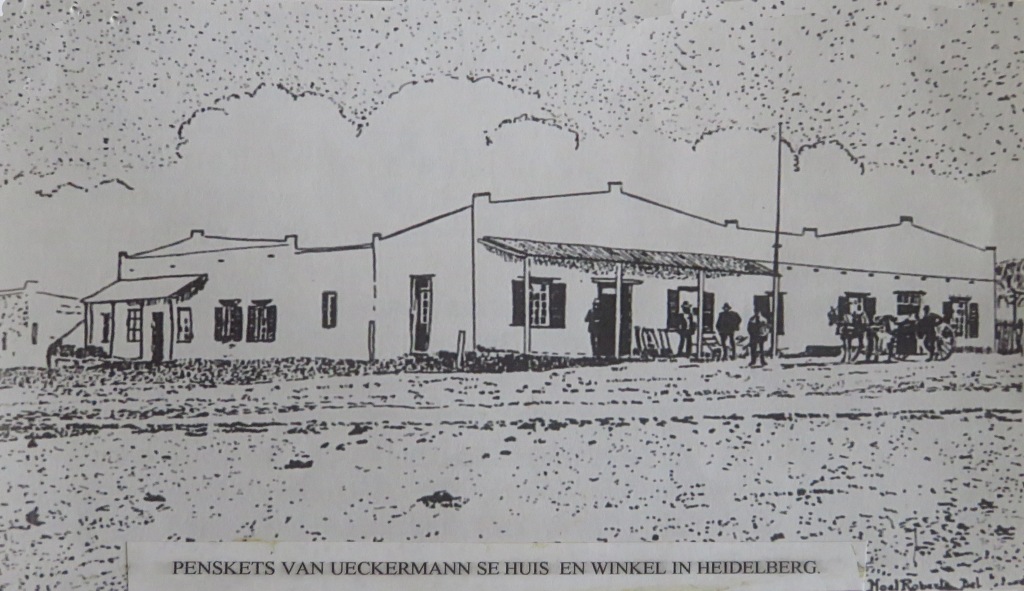 His business was obviously successful and he became a respected citizen of the town. Represented Heidelberg in the Volksraad (parliament) and was a member of the executive (uitvoerende raad). In business he not only had the shop, he also opened a chemist (which gave rise to the thought he may have studied pharmacology in Germany) and became a building contractor. He was also a member and the secretary of the Nederduits Herformde Kerk and it was under his supervision that the first church was build in 1864/65.
His business was obviously successful and he became a respected citizen of the town. Represented Heidelberg in the Volksraad (parliament) and was a member of the executive (uitvoerende raad). In business he not only had the shop, he also opened a chemist (which gave rise to the thought he may have studied pharmacology in Germany) and became a building contractor. He was also a member and the secretary of the Nederduits Herformde Kerk and it was under his supervision that the first church was build in 1864/65.
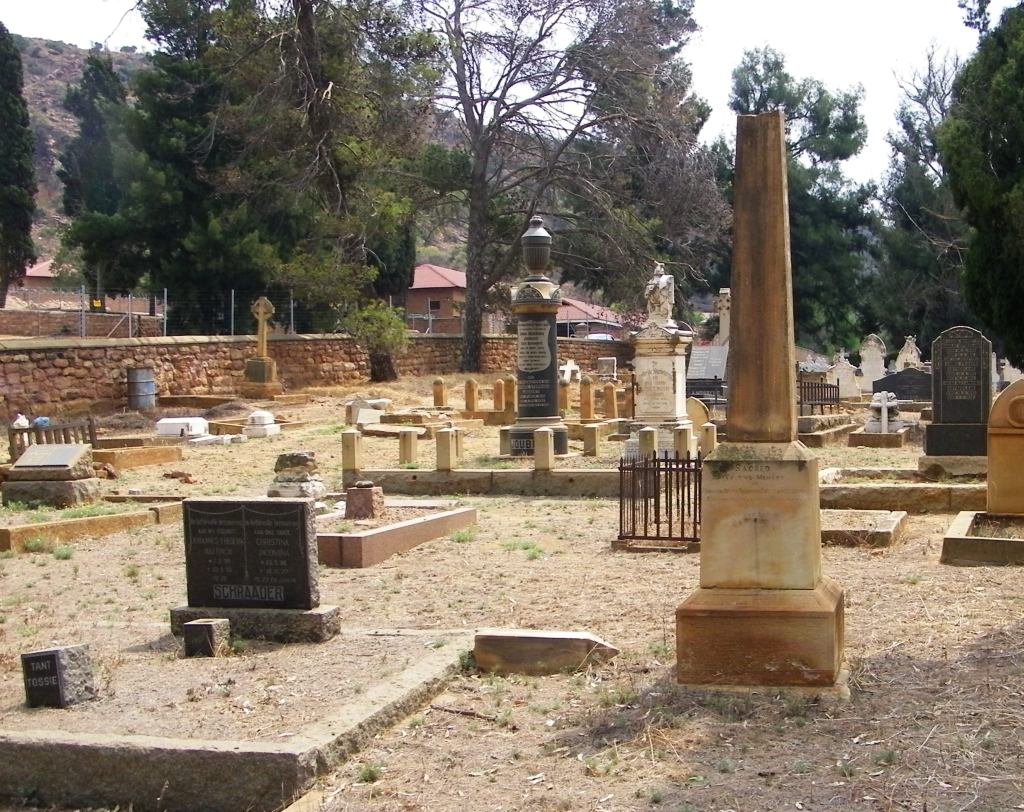 His grave is in the Kloof cemetery, the inscription on the grave stone reads:
His grave is in the Kloof cemetery, the inscription on the grave stone reads:
Sacred to the Memory of
Heinrich Julius Friedrich Christian Ueckermann
Born in Mecklenburg Germany
20th July 1827
Died 24th July 1883
A note: Mecklenburg is not a town or a place, it's a state in the Federal Republic of Germany. His exact place of birth is Schwerin, one of the major towns in Mecklenburg. And another note: we are actually dealing with nobility here. In the sources it states that Johan Jacobus Ueckerman received the title 'baron' in 1790, this could have been the grandfather of Heinrich.
Railway Station
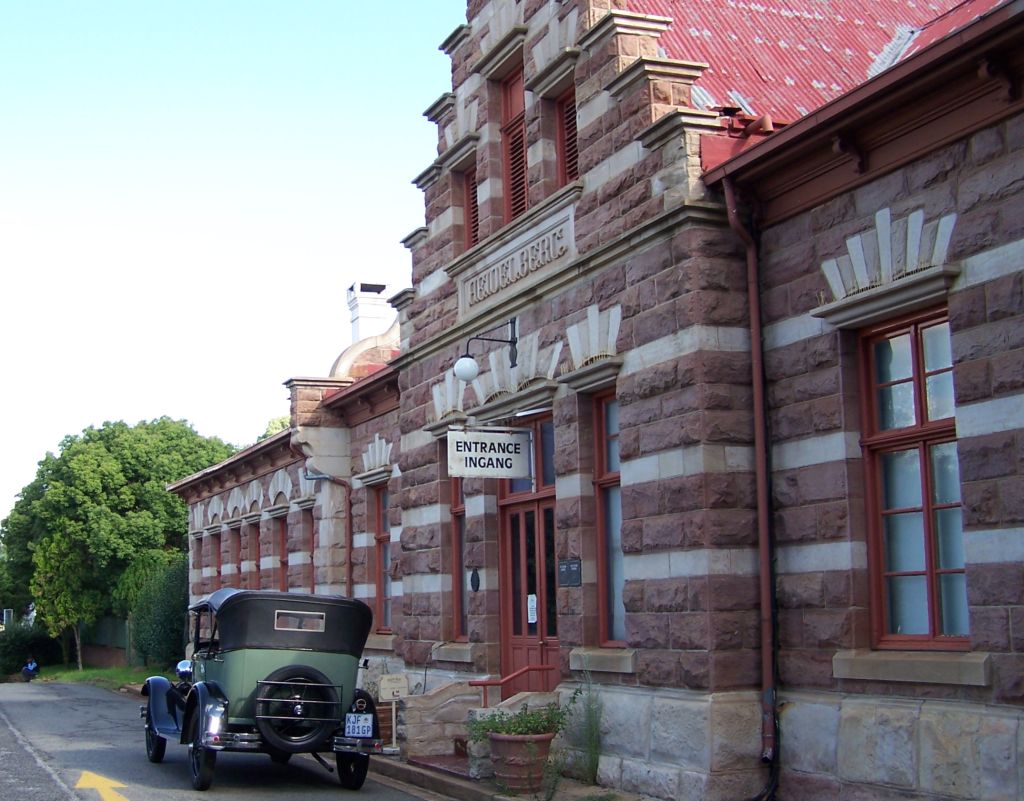 A beautiful sand stone building of red and white sand stone. NZASM (Nederlandsche Zuid-Afrikaansche Spoorweg Maatschappij) was the major railway company of the South African Republic (Transvaal), it was responsible for connecting the Natal line from Durban to Johannesburg. The station was completed in 1896. The observant visitor will notice that the station is not near the present rail, in fact its standing there isolated completely from any rail traffic. This is because the track was changed in 1961 and a new station erected some distance from the old one. The position of the old track can still be followed on Google Earth, coming in from Natal the line had a huge S-curve, that was possibly the reason for straightening the line somewhat.
A beautiful sand stone building of red and white sand stone. NZASM (Nederlandsche Zuid-Afrikaansche Spoorweg Maatschappij) was the major railway company of the South African Republic (Transvaal), it was responsible for connecting the Natal line from Durban to Johannesburg. The station was completed in 1896. The observant visitor will notice that the station is not near the present rail, in fact its standing there isolated completely from any rail traffic. This is because the track was changed in 1961 and a new station erected some distance from the old one. The position of the old track can still be followed on Google Earth, coming in from Natal the line had a huge S-curve, that was possibly the reason for straightening the line somewhat.
The disused station was purchased by the Rembrandt Group and a transport museum established. Unfortunately with the death of the founder, Anton Rupert, the museum was closed and most of the exhibits moved to the Cape.
Townhall
Built and completed in 1938. What makes it interesting is that the architect was Gerhard Moerdyk, the same guy that designed the Voortrekker Monument in Pretoria.
NG church
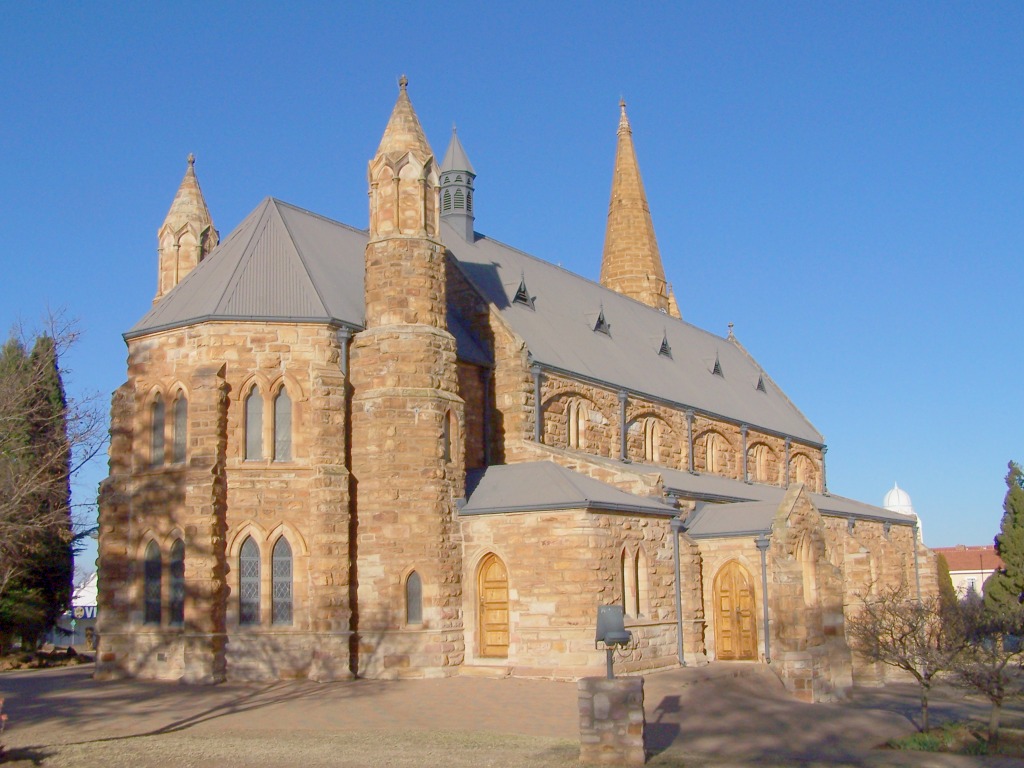 There are a number of churches in Heidelberg, I am picking here on the main NG church, that beautiful sand stone structure in the middle of town. It was built in 1890 and cost £17000. The inscription on the corner stone reads as follows:
There are a number of churches in Heidelberg, I am picking here on the main NG church, that beautiful sand stone structure in the middle of town. It was built in 1890 and cost £17000. The inscription on the corner stone reads as follows:
NEDERDUITSCH HERVORMDE of GEREFORMIERDE KERK
DEZE STEEN IS GELEEGD OP 12 APRIL 1890
DOOR P J JOUBERT COMMANDANT GENERAAL
HEIDELBERG Z.A.R.
Translated: Dutch Reformed or Reformed Church
this stone was laid on the 12 April 1890
by P J Joubert Commandant General
 The architect were Brislin and Seale and the Master builder J.B.Kirton.
The architect were Brislin and Seale and the Master builder J.B.Kirton.
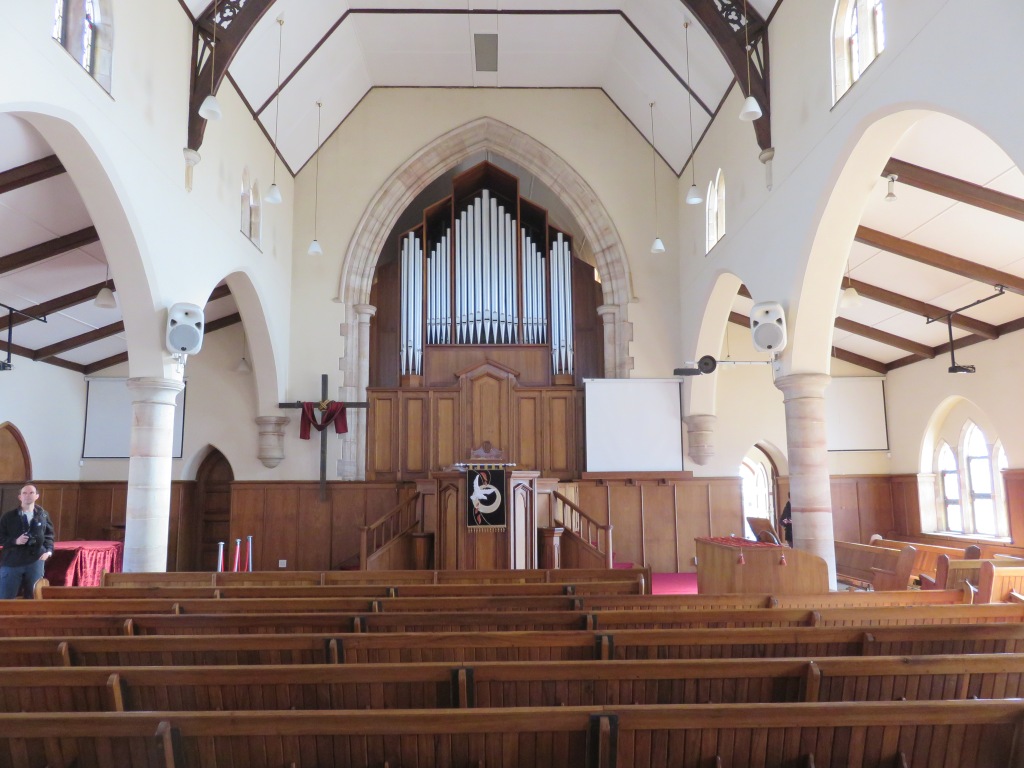 Why does the name of the two Afrikaans churches appear on the stone? During 1885 there was an attempt to unify the two streams, which in Heidelberg led to having a united congregation, they went about to build a church. But obviously at the time the name had not been agreed on yet thus the two names on the corner stone.
Why does the name of the two Afrikaans churches appear on the stone? During 1885 there was an attempt to unify the two streams, which in Heidelberg led to having a united congregation, they went about to build a church. But obviously at the time the name had not been agreed on yet thus the two names on the corner stone.
From ref.6 it looks like the unification didn't last, there is talk of a court case in 1897 to split up the property.
The big tower of the church collapsed in February 1909. Here is a picture of the fallen tower.It happened a few hours after the minister ds. A.J.Louw and some of his church council members had been up in the tower to inspect some building defects, I presume cracks had been appearing after a lengthy period of rain.
A new tower was constructed and inaugurated by J.D.Kestell in 1911.
NH church

 NH stands for Nederduitsch Hervormde Kerk, that is the other Afrikaans church in town. A church of pleasing architecture out- and inside. And no wonder, the architect was Gerard Moerdyk.
NH stands for Nederduitsch Hervormde Kerk, that is the other Afrikaans church in town. A church of pleasing architecture out- and inside. And no wonder, the architect was Gerard Moerdyk.
This church was built in 1932, before that the congregation used the church known as the Kruiskerk, in English cruciform church. It used to be on the same block as the present Klipkerk of the NG congregation. And Heinrich Ueckermann had something to do with that, see the story above. The foundation stone was laid on 17 October 1864 and cost was 6326 Pounds, 2 Shilling and 2 Pence.
Hoër Volkskool
 How do we translate this? Higher folkschool, doesn't sound right, its the high school for mainly Afrikaans speaking pupils.
How do we translate this? Higher folkschool, doesn't sound right, its the high school for mainly Afrikaans speaking pupils.
Expansion to a secondary school followed in 1919 with the erection of the present main building of the Hoër Volkskool (in the picture). The inscription in the corner stone reads: Hierdie Steen is gele deur se edele die Administrateur A.G.Robertson op 8ste September 1919; translated: This stone was laid by the honorable administrator A.G.Robertson on the 8th of September 1919.
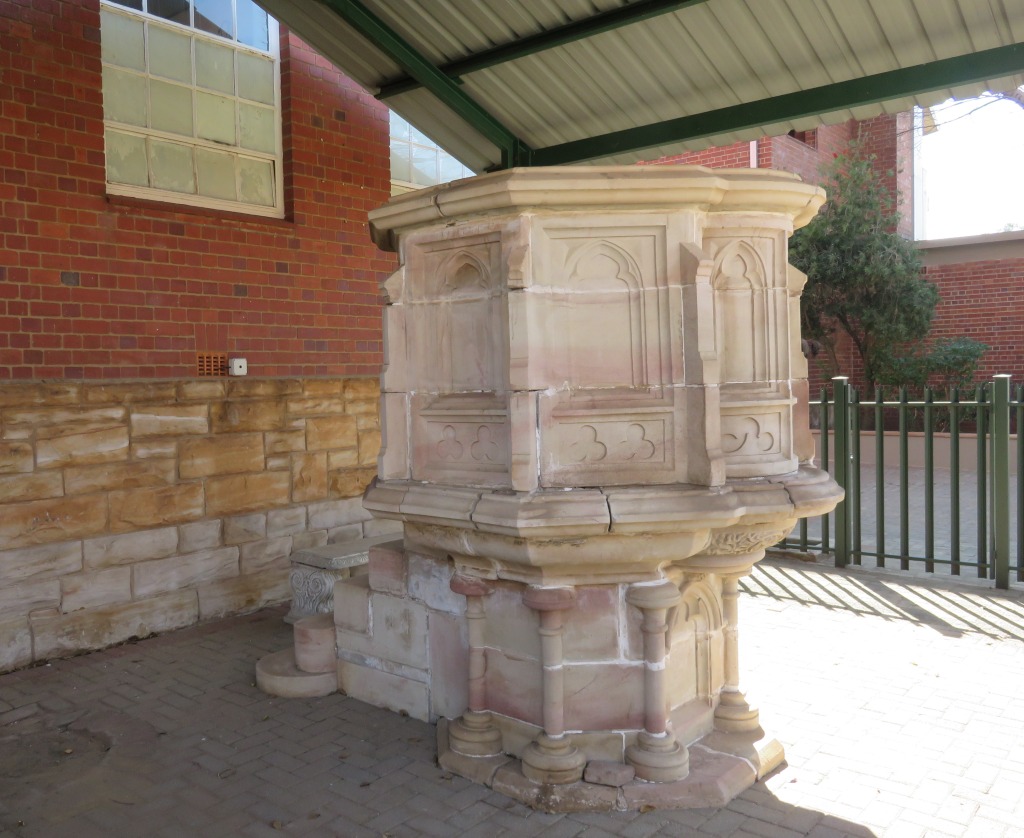 Something they do have in safe keeping at the school is the original pulpit (preekstoel) of the NG church. There is talk of moving it back to the church.
Something they do have in safe keeping at the school is the original pulpit (preekstoel) of the NG church. There is talk of moving it back to the church.
In recent times the school has had its fair share of mainly political problems. With the new political dispensation the school came under pressure to accommodate non-Afrikaans speaking pupils. A number of English media classes were established and maintained. In the meantime a English medium high school has been built and the school through its governing body has decided to discontinue with the dual medium. This, of course, caused an uproar under certain groups who feel that this is racism. A number of papers have reported on this subject, check this article, it seems a fair summary. One just has to wonder, how many of these complainers actually pay school fees.
Laer Volkskool
Heidelberg established itself as an educational center for the wider area. The basement of the Klipkerk was used as a class room and a new school erected in 1907, this was the Laer Volkskool, primary school.
Old Jail
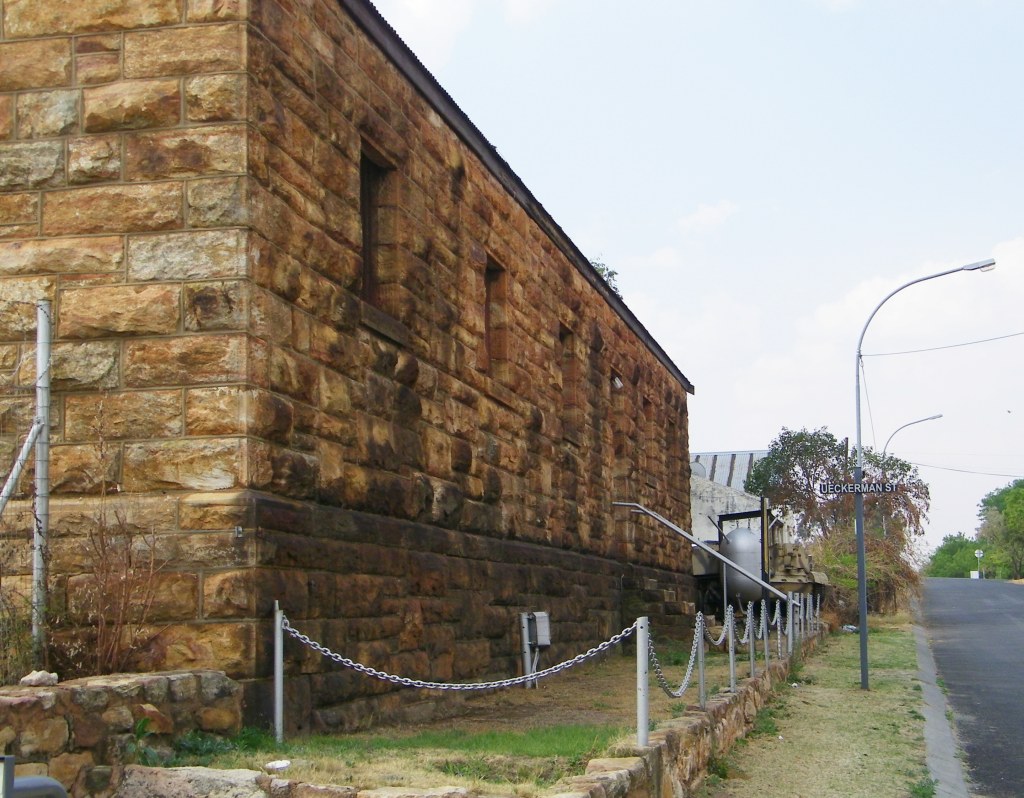 One reference I found states that the jail was built in 1888 but not used as a jail initially, it was a hospital. During the Boer War it was certainly used as a jail. Salomon van As was executed here, at the back of the jail.
One reference I found states that the jail was built in 1888 but not used as a jail initially, it was a hospital. During the Boer War it was certainly used as a jail. Salomon van As was executed here, at the back of the jail.
Salomon van As
Salomon van As was a field cornet during the Boer War as a member of the Heidelberg commando. He was involved in the killing of Captain R.C.H.Miers. The incident occurred during September 1901 at Riversdraai 12 miles south of Heidelberg. Captain Miers approached the Boers under a white flag most likely with the indention to convince them to surrender. What exactly happened is not known, the British claim the Captain was shot in cold blood which makes this a war crime, van As claims he acted in self defence.
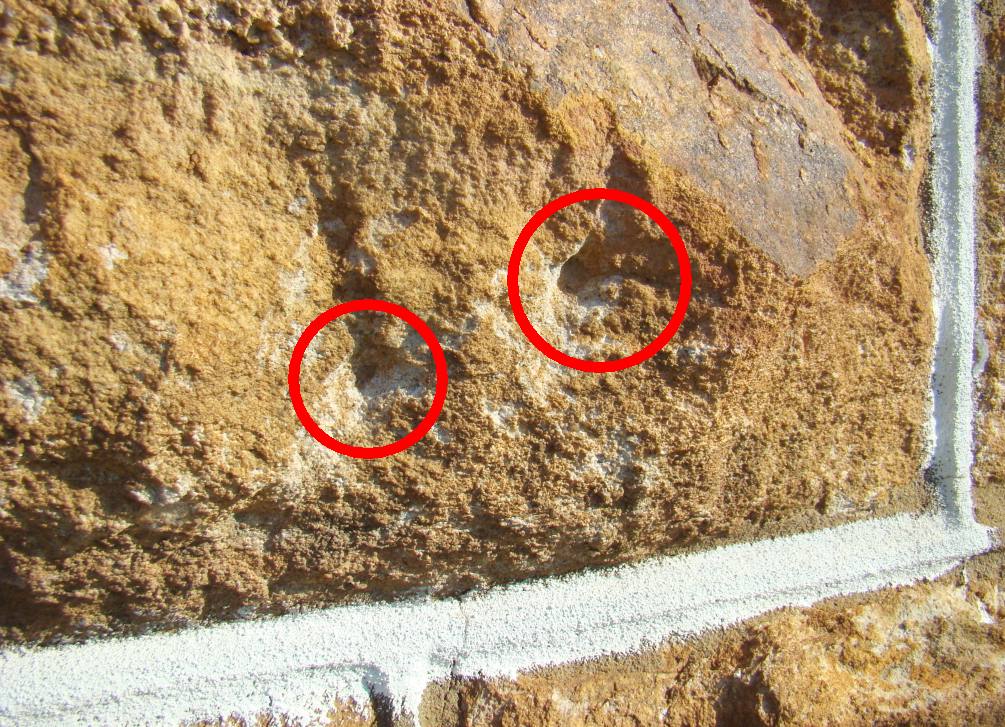 The British felt so strong about it that his name came up in the peace conference at Vereening as one of three burghers that had to hand themselves over to the British for investigation. He was imprisoned in the Heidelberg jail where the court case took place. Van As was not given the opportunity to call his own witnesses, found guilty and was condemned to die. The execution took place at the back of the jail, the bullet holes in the wall remain as witnesses to that event.
The British felt so strong about it that his name came up in the peace conference at Vereening as one of three burghers that had to hand themselves over to the British for investigation. He was imprisoned in the Heidelberg jail where the court case took place. Van As was not given the opportunity to call his own witnesses, found guilty and was condemned to die. The execution took place at the back of the jail, the bullet holes in the wall remain as witnesses to that event.
A few years after that the father of van As received a letter of apology from the British military, admitting that the court case was irregular and thus van As had not received a fair trial, compensation was offered to the family but refused.
Kloof Cemetery
What an interesting place. I must actually still go and spent a few hours there to capture everything of note.
This is what I have done now (June 16) I'll report under the various headings.
Thomas William Fannin
 The plaque on the graves states:
The plaque on the graves states:
Thomas William Fannin
Surveyor
of the Darcle, Natal
who laid out the town of Heidelberg
shortly before his death on
Dec. 19 1865
Requiescat in Pace
The last sentence is Latin and means 'rest in peace'. That name Darcle should actually be Dargle, looking at the inscription carefully I noticed a little piece hanging from the bottom of the C, obviously time has eaten away the details and it would have been a G initially. Dargle is an area near Pietermaritzburg. The farm was first occupied by Thomas Fannin 1848, but this is not Thomas Fannin the surveyor, but rather his father. Thomas Fannin senior died in 1862. An article describing some of the history can be found here.
TW Fanning was a surveyor from Natal who was moving through the area looking for work. Heinrich Ueckermann gave him the contract to lay out the new town. Unfortunately a severe attack of malaria caused his demise before he could finish the job. During his sickness he was nursed in the Ueckerman house. He was the first person to be buried in the Kloof cemetery.
DMHC Ueckermann
 Near the bottom of the cemetery, towards town, is a grave completely overgrown by a Yucca tree. With its spiky leaves it protects the grave plate very well, protecting against the weather and erosion and also against humans. Moving a couple of leaves I got a glimpse of the name Ueckermann, and that really set me going. I had a difficult job getting to the inscriptions. And what does it say on the one side (see picture):
Near the bottom of the cemetery, towards town, is a grave completely overgrown by a Yucca tree. With its spiky leaves it protects the grave plate very well, protecting against the weather and erosion and also against humans. Moving a couple of leaves I got a glimpse of the name Ueckermann, and that really set me going. I had a difficult job getting to the inscriptions. And what does it say on the one side (see picture):
SACP
To the memory of
DORETEA MARIE
HELENE CHRISTINE
UECKERMANN
And on the other side:
BORN WOHLITZ
AT STERNBERG
(MEC)KLENBURG SCHWERIN
13 JULY 1806
DIED 30 NOV 1870
REST IN PEACE
The three letters in brackets are not visible, they are unaccessible under the thick branch of the tree and have been assumed.
Searching through my sources I came to the conclusion that this is the mother of Heinrich. The background to this. There was another Ueckermann in the district, it was Carl August Friedrich, a brother of Heinrich. He joined him later in Heidelberg and was the first public prosecutor in 1868 and later a Justice of the peace. Carl was Heinrich's junior by 10 years and also made his way to South Africa at around 1860. He came with his mother, the sources state her name as Dorethea Marie Helene Caroline and she died in Heidelberg in November 1870.
Alfred Ueckermann
 John Alfred Ueckermann died whilst serving with the Heidelberg commando during the Boer War. I have not been able to find out how and why, I'll keep on looking.
John Alfred Ueckermann died whilst serving with the Heidelberg commando during the Boer War. I have not been able to find out how and why, I'll keep on looking.
He was a grandson of Heinrich Ueckerman and son of Frederick Ernest Ueckermann. Frederick was the first child born to Heinrich and Elizabeth in Pietermaritzburg 1851.
Graf Harra von Zeppelin
 On the memorial honoring the fallen comrades of the Heidelberg commando appears this name, Harra von Zeppelin. He was one of the German volunteers who had joined on the side of the Boers. When war became imminent some Germans formed a corp under the command of Oberst (colonel) Schiel. That unit saw action very early in the war at Elandslaagte, that is a railway station between Ladysmith and Dundee. It was in that battle that the German corp suffered heavy losses and it cost the life of the Graf von Zeppelin. According to witnesses he had received a shot to the head and barely conscious also received a wound when cut by a sabre and stabbed with a lance by the cavalry of the enemy. He survived the night and only died the next day.
On the memorial honoring the fallen comrades of the Heidelberg commando appears this name, Harra von Zeppelin. He was one of the German volunteers who had joined on the side of the Boers. When war became imminent some Germans formed a corp under the command of Oberst (colonel) Schiel. That unit saw action very early in the war at Elandslaagte, that is a railway station between Ladysmith and Dundee. It was in that battle that the German corp suffered heavy losses and it cost the life of the Graf von Zeppelin. According to witnesses he had received a shot to the head and barely conscious also received a wound when cut by a sabre and stabbed with a lance by the cavalry of the enemy. He survived the night and only died the next day.
 He had the rank of an officer and in the few days with the corp became very popular, although he insisted that his fellow comrades address him by his title 'Graf' (count). I could not find out anything about his life in the Transvaal before he joined the war. He must have lived there since he was with the action from the beginning.
He had the rank of an officer and in the few days with the corp became very popular, although he insisted that his fellow comrades address him by his title 'Graf' (count). I could not find out anything about his life in the Transvaal before he joined the war. He must have lived there since he was with the action from the beginning.
Why his remains were reinterned with fighters from the Heidelberg commando I do not know. I cannot find any connection in the literature between the Graf and the Heidelberg commando
British Boer war graves
 There is a large section of war graves for British soldiers killed during the 2nd Anglo Boer War. Most of them marked with the standard steel crosses and some with proper grave stones.
There is a large section of war graves for British soldiers killed during the 2nd Anglo Boer War. Most of them marked with the standard steel crosses and some with proper grave stones.
 Here we meet somebody we know from the Salomon van As episode above. Captain Miers who died as a result of the confrontation with van As. The full inscription reads:
Here we meet somebody we know from the Salomon van As episode above. Captain Miers who died as a result of the confrontation with van As. The full inscription reads:
In Memory of
Ronald Hill Macdonnald Capel
Miers,
Lieutenant 2nd Batt.
Somersetshire
Light Infantry,
and captain in the
South African Constabulary
was killed at
Riviersdraai near Heidelberg,
on 25st September 1901.
Concentration camp graves
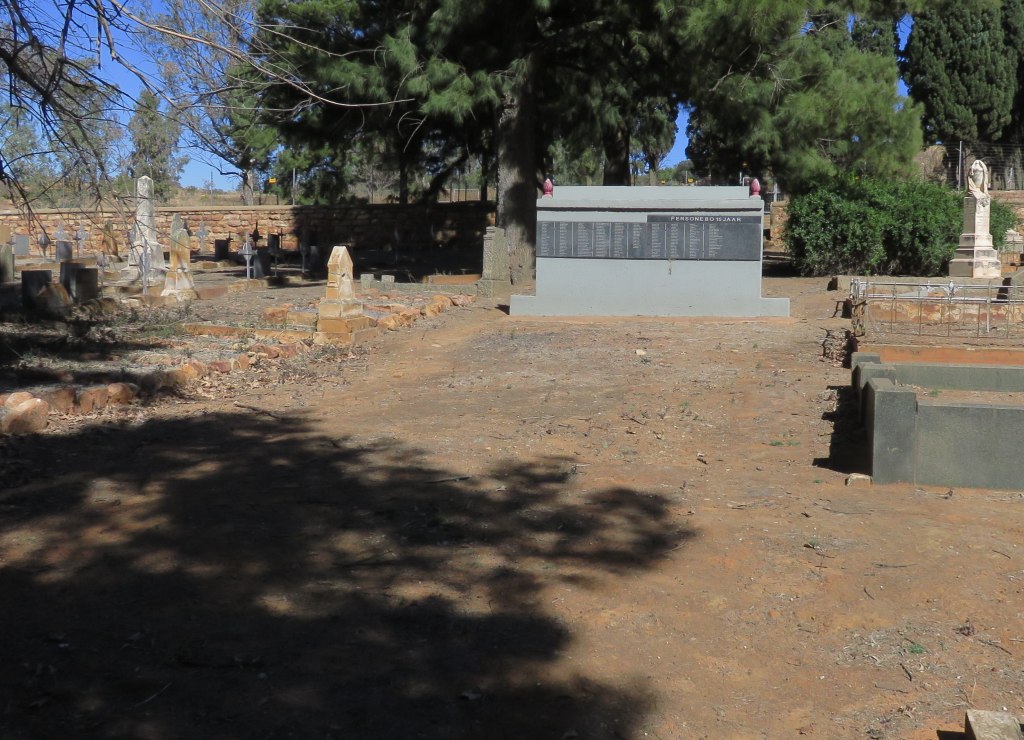
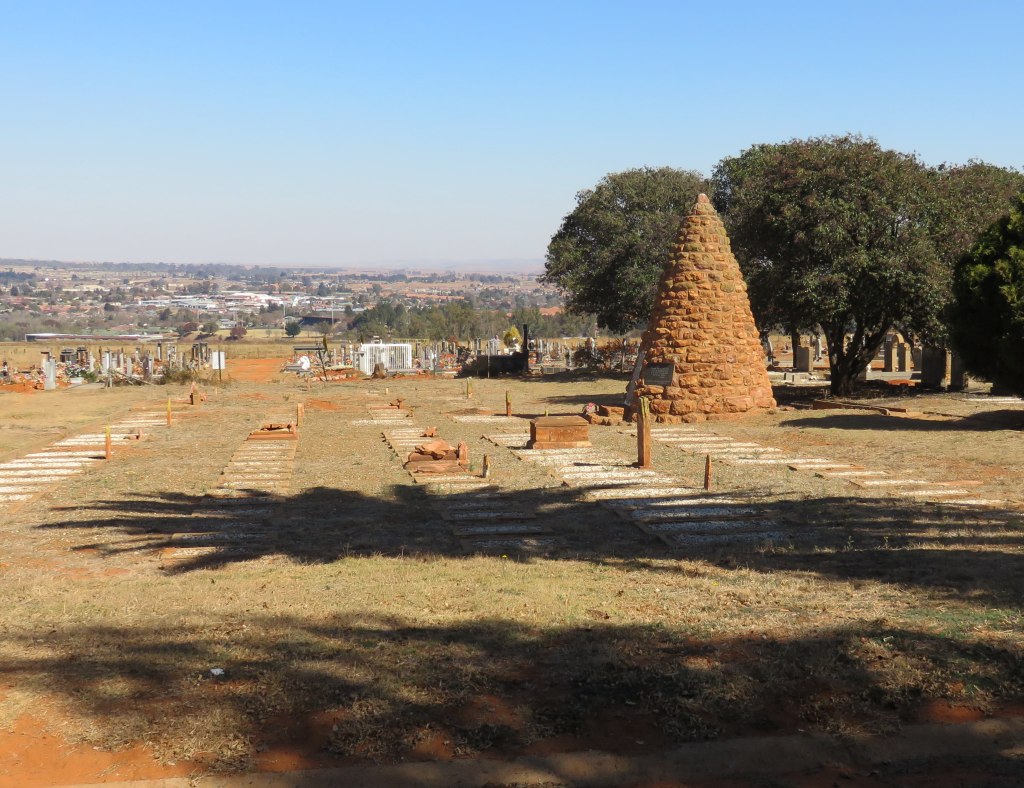 Concentration camps for the families of the Boers fighting in the war (Anglo Boer war 1899-1902) were established in many places in the country. What has been left behind from the concentration camps at Heidelberg are the graves of the mainly women and children who died here. There were three camps at Heidelberg, two for the boers and one for blacks.
Concentration camps for the families of the Boers fighting in the war (Anglo Boer war 1899-1902) were established in many places in the country. What has been left behind from the concentration camps at Heidelberg are the graves of the mainly women and children who died here. There were three camps at Heidelberg, two for the boers and one for blacks.
The graves are in two locations, one at this cemetery, Kloof, and the other location at what is called the camp cemetery. That one is on the way out of town toward Nigel. There should also be some graves from the black camp, the whereabout of that is not known, at least not to us.
Graves from the First Boer War
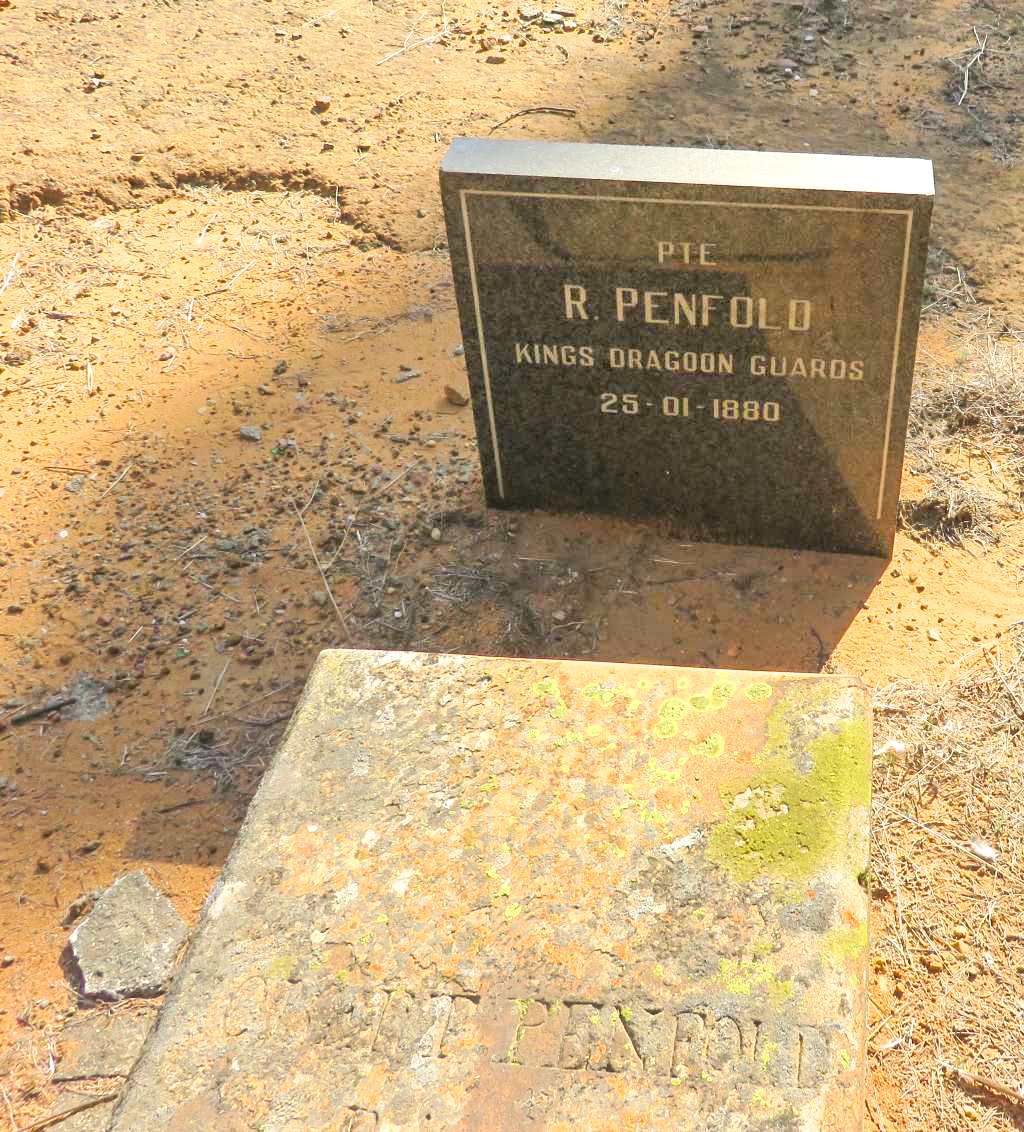 That is not 100% correct, the graves are marked January/February 1880, that was before hostilities with the Boers commenced. The two gravestones indicate that here lies Pte R.Penfold, Kings Dragoon Guard, 25-01-1880 and Pte L.H.Bradbury, Kings Dragoon Guard, 20-02-1880.
That is not 100% correct, the graves are marked January/February 1880, that was before hostilities with the Boers commenced. The two gravestones indicate that here lies Pte R.Penfold, Kings Dragoon Guard, 25-01-1880 and Pte L.H.Bradbury, Kings Dragoon Guard, 20-02-1880.
The heading is thus wrong, I couldn't think of anything better. The graves are certainly from the time of the annexation of the Transvaal by the British and the British army was present in the area. Although there was no garrison at Heidelberg, these must have been soldiers passing through or staying in a temporary camp.
Pieter Daniel Jacobs
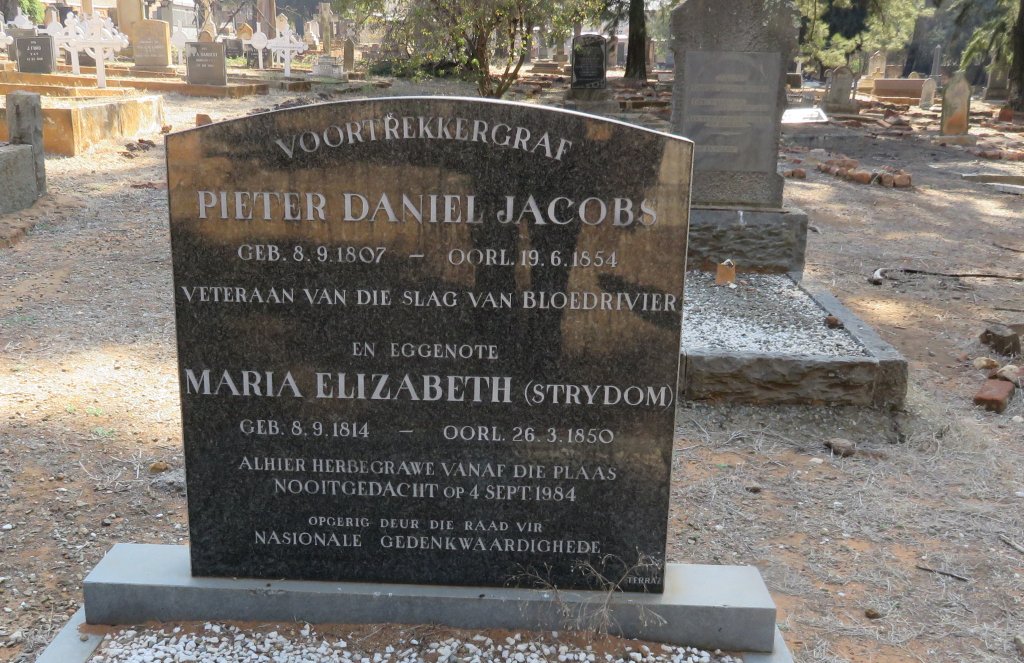 This grave had me a bit confused, because a person of the same name is buried at Goeiehoek not far from here. The name is the same, but the dates differ. The one resting here in Heidelberg is the son of Pieter Daniel at Goeiehoek. He came with senior from the Cape in 1838 to fight in the battle of Blood river. Coming back from the battle senior settled at Goedverwachting and junior at Nooitgedacht.
This grave had me a bit confused, because a person of the same name is buried at Goeiehoek not far from here. The name is the same, but the dates differ. The one resting here in Heidelberg is the son of Pieter Daniel at Goeiehoek. He came with senior from the Cape in 1838 to fight in the battle of Blood river. Coming back from the battle senior settled at Goedverwachting and junior at Nooitgedacht.
van Warmelo

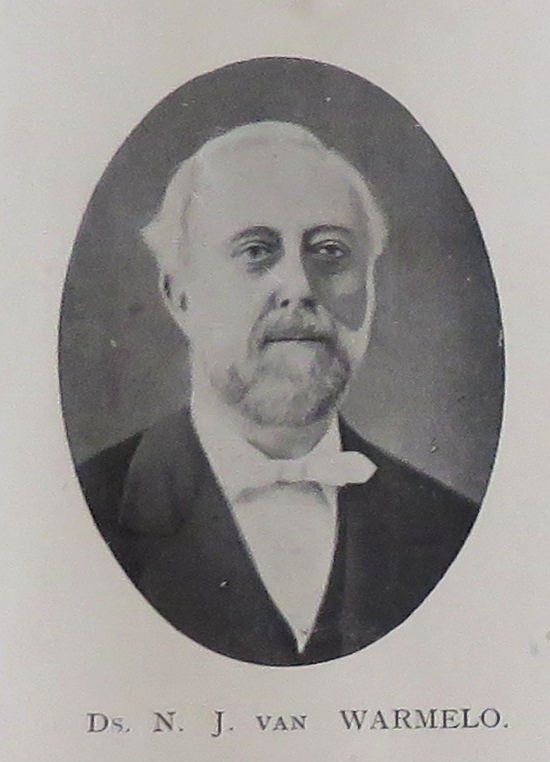 There are two graves, that I have come across, with the name 'van Warmelo'. The oldest one is that of Nicolaas Jacobus van Warmelo. He came from Holland and initially served the church in the Soutpanberg. He was called to be a minister of the Herformte Kerk in Heidelberg from 1868 and from 1885 for the united church until his death in 1892, see the write up about the church further back.
There are two graves, that I have come across, with the name 'van Warmelo'. The oldest one is that of Nicolaas Jacobus van Warmelo. He came from Holland and initially served the church in the Soutpanberg. He was called to be a minister of the Herformte Kerk in Heidelberg from 1868 and from 1885 for the united church until his death in 1892, see the write up about the church further back.
Dietlof van Warmelo is well known because he wrote a book, 'On Commando', about his time as a Boer soldier during the Boer War. He wrote it down whilst imprisoned in India, I like his style of writing, its very down to earth.
I can't find anything about his life after the war. He lived to a good old age of 94.
 It's in the family, his sister Johanna Brandt, known as Hansie, also wrote a book, that was 'The Petticoat Commando', it was a book about her time when she lived with her mother in Pretoria during the war. They acted as secret agents, smuggling messages to Holland under the noses of the British occupation force.
It's in the family, his sister Johanna Brandt, known as Hansie, also wrote a book, that was 'The Petticoat Commando', it was a book about her time when she lived with her mother in Pretoria during the war. They acted as secret agents, smuggling messages to Holland under the noses of the British occupation force.
References
1. Standard Encyclopaedia of Southern Africa, 1973
2. TV Bulpin, Lost Trails of the Transvaal, Thomas Nelson and Sons, 1965
3. Ian Uys, The Heidelbergers of the Boer War, 1981
4. W.J.Leyds. Die erste Annexion Transvaals, Verlag Emil Felber, 1907
5. E.F.Sandeman, Eight month in an Ox-Wagon, Griffith and Farran, 1880
6. "Ons Kerk Album van Hollandsche Kerken en Leeraren", printed by Cape Times, 1917
7. verbal and written communication from Heinrich Ueckerman, one of the grandsons of the original HJFC Ueckerman and from Anjoret van Niekerk
8. 150 Jaar van Genade - Feesblad van die NG Gemeente Heidelberg - Klipkerk (1865-2015), printed by Heidelberg Printers.
9. The Ueckermann Families in South Africa, privately published by Ludwig Döhne, 2009
10. Joseph Kürschner, Die Buren und der Südafrikanische Krieg, Deutscher Kunstverlag,1902
11. Dietlof van Warmelo, 'On Commando', Methuen & Co, 1902